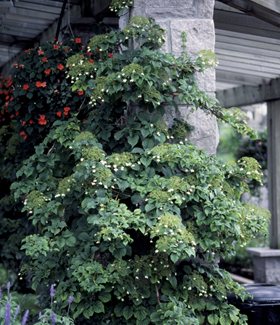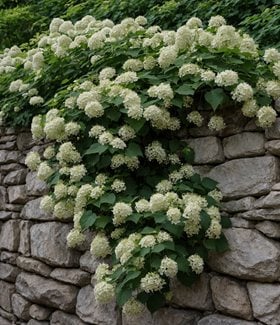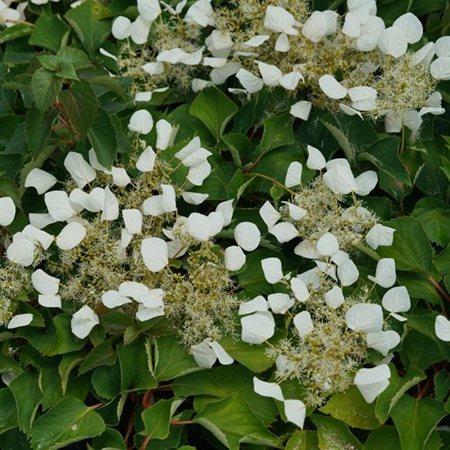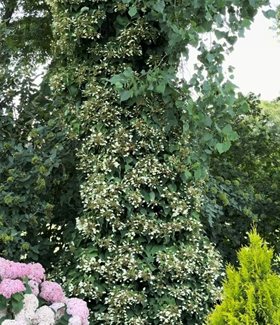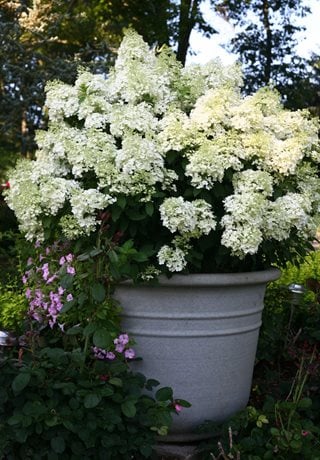HOW TO GROW CLIMBING HYDRANGEA: VARIETIES, PLANTING & CARE TIPS
Grow this versatile perennial vine to add lush color and elegance to your yard.Hydrangeas are one of the most popular landscape shrubs, with showy oversized flowers that occur from late spring into fall. There are also climbing forms that can be trained vertically up buildings, tree trunks, and structures, or allowed to sprawl horizontally as a ground cover. This versatile deciduous or evergreen vine thrives in sun or shade, and is virtually maintenance-free once established, adding multi-seasonal structure and color to the landscape.
Most hardy deciduous species are native to Asia, while tender evergreen forms originate in Mexico, Central America, South America, and parts of Asia. The delicate white lacecap flowers that occur in late spring and summer are attractive to bees and other insect pollinators.
This climbing vine develops aerial roots along the woody stems, allowing it to cling to walls, fences, trellises, arbors, or buildings without supplemental support. Once established, these vines can reach up to 50 feet tall. Here’s more on how to plant, grow and use climbing hydrangea in your yard.
On this page: Basics | Planting | Care | Varieties | FAQs | Landscaping Tips
- BASICS
- PLANTING CLIMBING HYDRANGEAS
- CLIMBING HYDRANGEA CARE
- CLIMBING HYDRANGEA VARIETIES
- FREQUENTLY ASKED QUESTIONS
- LANDSCAPING TIPS
BASICS
Botanical name:
Hydrangea anomala and H. anomala spp. petiolaris
Common names:
Climbing hydrangea; species may have different common names
Plant type:
Deciduous or evergreen vine
Zones:
4-9
Exposure:
Full sun to shade
Habit:
Vining spreading habit
Height/spread:
10 to 50 feet tall, 3 to 15 feet wide
Bloom time:
Late spring to summer
Flowers:
Large, showy white flower heads have a lacecap form, with clusters of tiny fertile florets in the center surrounded by larger four-petaled sterile flowers.
Foliage:
Heart-shaped or lance-shaped foliage is deciduous or evergreen, with smooth or serrated edges, a dull or glossy sheen, and solid green or variegated patterns. Foliage in fall is yellow or insignificant.
Toxicity:
All hydrangeas contain hydrangin, a compound that is toxic to humans and animals if ingested. Since hydrangeas have a bitter taste, they are generally not consumed in amounts large enough to cause distress. Seek medical advice if you suspect your child or pet has ingested any part of the plant.

'Miranda’ climbing hydrangea clamors up a tree in
the shady garden of Vina Winters in West Linn, OR.
Photo: Janet Loughrey
PLANTING CLIMBING HYDRANGEAS
When to plant:
The best time to plant climbing hydrangea is during cooler months in spring or fall. Wait until all danger of frost is past in spring. In fall, plant at least 6 weeks before the first hard frost in your area to allow roots to become established.
Where to plant:
Choose a site with full sun to partial shade and well-drained soil. Provide afternoon shade or dappled shade in hotter climates. Vines should be located adjacent to a building, structure or tree that is strong enough to support this larger vine.
How to plant:
Loosen soil in the planting area and amend with organic matter to add nutrients and improve drainage. Dig a hole twice as wide and the same depth as the root ball. Remove plant from its nursery pot and gently tease out roots if potbound. Place in the hole so the top of the root ball is level with the surrounding soil. Fill the planting hole with soil and gently tamp down to remove air pockets. Water well, providing regular water until plants are established.
CLIMBING HYDRANGEA CARE
Watering:
Climbing hydrangeas are drought tolerant once established, but perform best with moderate moisture. Provide regular water and avoid overwatering to prevent root rot. Water more frequently during prolonged heat or dry spells.
Soil:
Climbing hydrangeas can tolerate a range of soils, performing best in moist, well-drained soil with a slightly acidic to neutral pH of 5.5 to 7.0. Add compost or other rich organic matter to improve drainage and provide nutrients. Mulch around the base of plants with wood chips or bark to suppress weeds, retain moisture, and cool the root zone.
Amendments & fertilizer:
When planted in well-amended soil, these plants needs little or no supplemental fertilizer. If desired, a slow-release balanced fertilizer can be applied in early spring according to package instructions. Mulch plants with compost, shredded bark, or wood chips to provide additional nutrients.
Pruning:
To keep plants a certain size, or to train vines, climbing hydrangea will need regular pruning. Since they bloom on old wood, the best time to prune is just after plants have finished flowering. Remove dead, damaged or diseased growth and lightly shape plants as needed. If plants become overgrown, trim back to the desired size.
Training vines:
Though these woody vines cling to structures or trees with their aerial roots without support, they will benefit from initial training to get them to grow in the proper direction. Use string or twist ties to fasten branches to fencing, arbors, pergolas, and trellises, encouraging branches to grow vertically or horizontally, depending on the structure and desired effect. Plants will eventually cling on their own without additional support.
Pests and diseases:
When grown in the right conditions, climbing hydrangea is resilient to most pests and diseases. Pests can include aphids, scale, and spider mites. Diseases include bacterial wilt, botrytis, leaf spot, powdery mildew, and root rot.
VARIETIES OF CLIMBING HYDRANGEAS
CLIMBING HYDRANGEA
(Hydrangea anomala subsp. petiolaris)
Zones: 4-8
Exposure: Full sun to full shade
Height/Spread: 30 to 50 feet tall, 5 to 6 feet wide
Bloom time: Spring to summer
Color: Green foliage, white flowers
Hydrangea anomala is native to the Himalayas and China, where as H. anomala spp. petiolaris is native to Siberia, Japan, China, and South Korea. The latter considered to be more ornamental, with larger growth and flower clusters, and better winter hardiness. These are the most commonly grown climbing hydrangeas and produce dark green heart-shaped leaves and creamy white lacecap flowers from late spring into summer. Mature plants develop attractive peeling bark that adds winter color to the landscape. Protect from hot afternoon sun.
'FIREFLY'
(Hydrangea anomala)
Zones: 4-8
Exposure: Full sun to partial shade
Height/Spread: 10 to 30 feet tall, 5 to 10 feet wide or more
Bloom time: Late spring to summer
Color: Green and yellow variegated foliage, white flowers
‘Firefly’ is a deciduous vine grown for the showy variegated foliage, with green and yellow coloring, serrated edges and a glossy sheen. The creamy yellow margins mature to chartreuse in summer. Use this variety to brighten up dark shady areas.
'FLYING SAUCER'
(Hydrangea anomala subsp. petiolaris)
Zones: 4-8
Exposure: Full sun to partial shade
Height/Spread: 15 to 30 feet tall, 5 to 10 feet wide
Bloom time: Late spring to summer
Color: Green foliage, white flowers
This climbing hydrangea variety is named for the large creamy white blooms with a flat rounded shape that resemble flying saucers. New growth of the heart-shaped serrated leaves emerges lime-green, fading to dark green as it matures. Use to create a lush green living wall.
'MIRANDA'
(Hydrangea anomala subsp. petiolaris)
Zones: 4-8
Exposure: Partial or dappled shade
Height/Spread: 30 to 50 feet tall, 5 to 6 feet wide
Bloom time: Late spring to early summer
Color: Green and yellow foliage, white flowers
This showy variegated variety produces green heart-shaped leaves with irregular yellow margins for stunning contrast. In late spring, plants produce large fragrant white flowers 6 to 8 inches across. Mature vines have cinnamon-brown exfoliating bark, adding winter interest to the landscape. Grow along a wall or allow to sprawl as a ground cover.
'SILVER LINING'
(Hydrangea anomala subsp. petiolaris)
Zones: 4-8
Exposure: Full sun to partial shade
Height/Spread: 20 to 40 feet tall, 6 to 12 feet wide
Bloom time: Summer
Color: Gray-green and white foliage, white flowers
‘Silver Lining’ is a climbing hydrangea cultivar with stunning grey-green leaves that have irregular creamy-white margins. This deciduous vine produces large fragrant white flower panicles during summer that beautifully complement the elegant foliage. Provide morning sun and afternoon shade for best coloring and flower production. Use to brighten up darker shady areas such as a courtyard or woodland garden.
Flirty Girl® False Hydrangea Vine
(Schizophragma hydrangeoides)
Zones: 5 to 9
Mature size: Up to 50 feet tall
'Flirty Girl' Japanese hydrangea vine is a vining woody perennial that is commonly mistaken for climbing hydrangea (Hydrangea spp.). Also known as false hydrangea vine or Japanese hydrangea vine, this hardy deciduous plant is in the hydrangea family (Hydrangeaceae), producing serrated heart-shaped leaves and showy lacecap flowers in mid-summer. Schizophragma is distinguished by single petaled white or pink flowers that surround the clusters of tiny fertile florets. Plants have aerial roots similar to climbing hydrangeas.
“One of the problems with Schizophragma and climbing hydrangeas is that they can take a while to mature and produce flowers. Flirty Girl® false hydrangea-vine solves this issue, producing beautiful flowering 2 or 3-gallon plants with loads of light fragrant white blooms.” — Spring Meadow Nursery.
FREQUENTLY ASKED QUESTIONS
How long before climbing hydrangeas bloom?
Climbing hydrangeas are slow growers, taking 3 to 5 years to reach the blooming stage. Once established, vines grow up to 50 feet tall, producing an abundance of flowers from late spring into summer.
Do climbing hydrangeas need support?
They cling on their own but benefit from initial training.
Will climbing hydrangeas damage brick or rock?
Yes, the aerial roots or "clingfasts" attach to rough surfaces such as mortar, stucco, wood siding, tree bark, and can cause damage even if structures are in good condition with no visible cracks or fissures. They are best used on mortarless rock surfaces, heavy timbered pergolas, or as mounding ground covers. Prune back plants if they become overgrown.
How fast do climbing hydrangeas grow?
Climbing hydrangeas have a slow to medium growth rate, reaching full mature size in 10 to 15 years. Plants can reach 30 to 50 feet tall.
Do climbing hydrangeas bloom in shade?
Yes, though they may bloom more heavily with some sun.
Do climbing hydrangeas need winter protection?
Deciduous climbing hydrangea varieties are hardy in most growing zones. In colder climates, plant in protected sites. For younger plants, provide added protection by wrapping with burlap. Mulch around the base of plants to protect the roots. Water plants thoroughly before the ground freezes to prevent dehydration.
Are climbing hydrangeas evergreen?
Climbing hydrangeas occur in evergreen and deciduous varieties. Deciduous species are hardy in colder climates, down to USDA zones 4-5. Evergreen varieties originate from warmer regions, and are hardy to USDA zones 7-8.
Are climbing hydrangeas invasive?
Though climbing hydrangeas can grow large and have an extensive root system, they are not considered invasive by re-seeding. Do not allow plants to become overgrown; control growth with timely pruning.
LANDSCAPING WITH CLIMBING HYDRANGEAS
When growing climbing hydrangea vertically, make sure to use a structure that can hold its weight. The vertical growth habit is useful for narrow areas where space is limited. Here are some ideas on how to use climbing hydrangea in your yard:
For borders and landscapes: Use climbing hydrangea as a focal point in a woodland garden, courtyard, or trained vertically using an offset trellis to keep the roots off the main structure. Do not plant on living trees. Plants can be used to soften hardscapes including mortarless walls or heavy-timbered arbors or pergolas.
For slopes and hillsides: Climbing hydrangea can be allowed to sprawl as a ground cover to cover a slope or hillside, providing superficial erosion control.
For containers: Smaller specimens can be grown in containers temporarily. Provide a large pot at least 18 inches wide and deep. Plants will eventually outgrow their pot and need transplanting into the ground.
- Grow climbing hydrangea up a brick or stone chimney to soften the facade.
- Allow a climbing hydrangea to cascade dramatically over a large rock wall.
- Use climbing hydrangea to cover a tree stump, rock pile, old shed, or other unsightly feature.
- Plant a climbing hydrangea in a woodland garden and allow it to sprawl horizontally as a ground cover.
- Train climbing hydrangea up and across the top of a pergola or arbor as a shady screen to cool off a seating area.
Companion plants:
Choose companion plants that will thrive in the same growing conditions of full sun to shade, moderate moisture and average to rich soil. These include astilbe, azalea, boxwood, coral bells, daylily, dogwood, ferns, foxglove, hardy geranium, hosta, Japanese forest grass, Japanese maple, spirea, and sweetspire.
RELATED:
How to Grow & Care for Hydrangeas
Types of Hydrangeas
21 Flowering Vines to Grow
